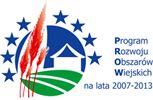The Finding and the Exaltation of the Holy Cross church in Korycin
The beginnings of the Parish of the Finding and Exaltation of the Holy Cross in Korycin are not well known. It is supposed that the first church already existed here in the 16th century. It had been built in some distance from the village, in a place called Dąbrówka. The parish and another wooden church were founded in 1601 by Hieronim Wołowicz, the treasurer and leaseholder of the crown lands. He did it with the consent of King Sigismund III Vasa, the nominal owner and official collator of the church. We do not know exactly when the next wooden churches were built here. On a photo from the end of the 19th century there is a large, tower-less temple topped with a small bell-gable, probably constructed in the 18th century.
The current brick church was built in the years 1899-1905 according to a design by Jan Hinz. A cornerstone with the date of the commencement of the construction is still visible in its basement. Most costs were borne by the parishioners who also provided bricks manufactured in the nearby villages of Krukowszczyzna, Czarnystok and Zagórze.
The church was severely damaged during both world wars. In September 1915 it was bombed with canon shells by the German and Russian armies. The entire roof was demolished then, and the walls and vaults impaired. The repairs took place in the years 1921-1923. Thirty years later, on the night of 29th to 30th July 1944, the retreating Nazis troops installed powerful explosives under the towers. The left tower collapsed entirely along with the western part of the aisles and the choir balcony, but the right tower survived, because the explosive of 120 kg did not go off.
The reconstruction of the church lasted until the 1970s. Since 1945 to 1947 the roof, vault and side walls were repaired, the preserved tower was strengthened and the lower storey of the demolished one was rebuilt. In 1972 the collapsed tower was raised.
The Neo-Gothic church was built of yellow bricks on the plan of a Latin cross. Two slender towers topped with openwork domes grace it from the front, side elevations are cut by enormous windows filled with bricked traceries and separated with buttresses. Under the cornice there is a decorative frieze made of four-leaf rosettes of colourful bricks. The three-aisle interior of the church is covered with a stellar vault, the ribs of which flow down onto the capitals of the pillars decorated with acanthus leafs.
The Neo-Gothic elements: the altars and pulpit, are made of wood. The main and two side altars: of Transfiguration of Jesus and of the Mother of God date back to the years 1912-1915, the other two: of St. Francis of Assisi and the Sacred Heart are newer (the 1940s-1960s). In the main altar there is a sculptural group depicting the scene of the crucifixion and figures of the most important Polish saints: Adalbert the Bishop, Stanislaus the Bishop, Casimir the Prince and Stanislaus Kostka. In the right side altar there is a painting of Mother of God (17th-18th century), brought from Rome in 1834, covered with a silver dress. Our attention is also drawn by a Neo-Gothic pulpit surmounted with a slim pinnacle with a figure of the Good Shepherd.
In the wall surrounding the churchyard cemetery there is a two-storey cobblestone belfry-gate, and four wooden chapels built on square plan and boarded vertically with listing. They were erected in the second half of the 18th century, before the construction of the contemporary church. Beyond the churchyard cemetery, in a previous parsonic park, stands a brick parsonage from the interwar period.

The current brick church was built in the years 1899-1905 according to a design by Jan Hinz. A cornerstone with the date of the commencement of the construction is still visible in its basement. Most costs were borne by the parishioners who also provided bricks manufactured in the nearby villages of Krukowszczyzna, Czarnystok and Zagórze.
The church was severely damaged during both world wars. In September 1915 it was bombed with canon shells by the German and Russian armies. The entire roof was demolished then, and the walls and vaults impaired. The repairs took place in the years 1921-1923. Thirty years later, on the night of 29th to 30th July 1944, the retreating Nazis troops installed powerful explosives under the towers. The left tower collapsed entirely along with the western part of the aisles and the choir balcony, but the right tower survived, because the explosive of 120 kg did not go off.
The reconstruction of the church lasted until the 1970s. Since 1945 to 1947 the roof, vault and side walls were repaired, the preserved tower was strengthened and the lower storey of the demolished one was rebuilt. In 1972 the collapsed tower was raised.
The Neo-Gothic church was built of yellow bricks on the plan of a Latin cross. Two slender towers topped with openwork domes grace it from the front, side elevations are cut by enormous windows filled with bricked traceries and separated with buttresses. Under the cornice there is a decorative frieze made of four-leaf rosettes of colourful bricks. The three-aisle interior of the church is covered with a stellar vault, the ribs of which flow down onto the capitals of the pillars decorated with acanthus leafs.
The Neo-Gothic elements: the altars and pulpit, are made of wood. The main and two side altars: of Transfiguration of Jesus and of the Mother of God date back to the years 1912-1915, the other two: of St. Francis of Assisi and the Sacred Heart are newer (the 1940s-1960s). In the main altar there is a sculptural group depicting the scene of the crucifixion and figures of the most important Polish saints: Adalbert the Bishop, Stanislaus the Bishop, Casimir the Prince and Stanislaus Kostka. In the right side altar there is a painting of Mother of God (17th-18th century), brought from Rome in 1834, covered with a silver dress. Our attention is also drawn by a Neo-Gothic pulpit surmounted with a slim pinnacle with a figure of the Good Shepherd.
In the wall surrounding the churchyard cemetery there is a two-storey cobblestone belfry-gate, and four wooden chapels built on square plan and boarded vertically with listing. They were erected in the second half of the 18th century, before the construction of the contemporary church. Beyond the churchyard cemetery, in a previous parsonic park, stands a brick parsonage from the interwar period.













